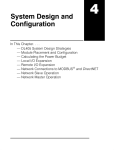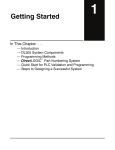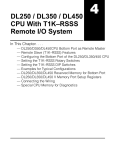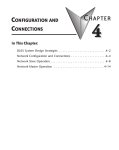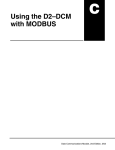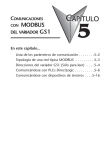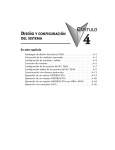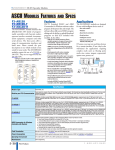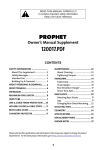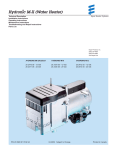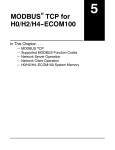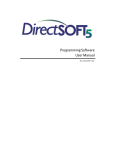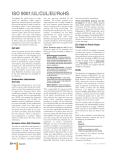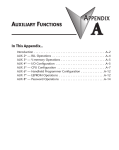Download Chapter 4 - AutomationDirect
Transcript
System Design and Configuration 14 In This Chapter. . . . — DL305 System Design Strategies — Module Placement — Calculating the Power Budget — Expansion I/O — Remote I/O — Network Connections to MODBUS and DirectNET — Network Slave Operation — Network Master Operation 4--2 System Design and Configuration DL305 System Design Strategies I/O System Configurations The DL350 CPU offers the following ways to add I/O to the system: S Local I/O -- consists of I/O modules located in the same base as the CPU. S Remote I/O -- consists of I/O modules located in bases which are serially connected to the bottom port on a DL350 CPU. S Expansion I/O -- consists of I/O modules located in expansion bases located close to the local base. Expansion cables connect them to the local CPU base’s serial bus in a daisy--chain fashion. A DL305 system can be developed using many different arrangements of these configurations. All I/O configurations use the standard complement of DL305 I/O modules and bases. Networking Configurations The DL350 CPU offers the following way to add networking to the system: S DL350 Communications Port -- The DL350 CPU has a 25--Pin connector on Port 2 that provides a built--in RTU MODBUS connection. S MODBUS Master Module-- MODBUS master modules can be used in any slot for connecting as a master to a MODBUS network. S MODBUS Slave Module-- MODBUS slave modules can be used in any slot for connecting as a slave to a MODBUS network. Module/Unit System Design and Configuration DL350 CPU Base Configurations Master DirectNET MODBUS RTU Slave DirectNET K--Sequence MODBUS RTU The DL305 system currently offers two types of bases. Both types come in 5, 8, or 10 slot configurations. All DL305 CPUs will work in either type of base. The xxxxx--1 bases are designed to compliment the features of the DL350 CPU, however all other DL305 CPUs will work in these bases. You can also mix the bases in a system. By mixing the bases or by installing the DL350 in an conventional base, you will loose some of the features of the CPU. The DL350 will revert back to 8--bit addressing and will virtually function like a DL340 CPU. This section will focus on the xxxxx--1 bases using the DL350 CPU. If you will be using the DL350 in a conventional base or if you are mixing bases in a system, refer to Appendix F for base, I/O, and module placement information. The xxxxx--1 bases support a 8 bit parallel bus that allows the use of intelligent modules when using the DL350 CPU. The addressing scheme is simplified and also extends the number of I/O points you can use. You will have a bigger power budget to work with due to the increase in the power supply capacity to 2.0A. DL350 User Manual, 2nd Edition System Design and Configuration 4--3 Module Placement Slot Numbering The DL305 bases each provide different numbers of slots for use with the I/O modules. You may notice the bases refer to 5-slot, 8-slot, etc. One of the slots is dedicated to the CPU, so you always have one less I/O slot. For example, you have four I/O slots with a 5-slot base. The I/O slots are numbered 0 -- 3. The CPU slot always contains a CPU and is not numbered. The examples below show the I/O numbering for a 5 slot local CPU base with 8 point I/O and a 5 slot local CPU base with 16 point I/O. 5 Slot Base Using 8 Point I/O Modules 5 Slot Base Using 16 Point I/O Modules 060 to 067 040 to 047 Slot Number: 3 2 I/O Module Placement Rules 020 to 027 000 to 007 C P U DL305 070 to 077 020 to 027 000 to 007 050 030 010 to to to 057 037 017 Slot Number: 3 2 1 0 C P U DL305 1 0 There are some limitations that determine where you can place certain types of modules. Some modules require certain locations and may limit the number or placement of other modules. The table on pages 4-6 and 4-7 should clear up any gray areas in the explanation and you will probably find the configuration you intend to use in your installation. In all of the configurations mentioned the number of slots from the CPU that are to be used can roll over into an expansion base if necessary. For example if a rule states a module must reside in one of the six slots adjacent to the CPU, and the system configuration is comprised of two 5 slot bases, slots 1 and 2 of the expansion base are valid locations. The following table provides the general placement rules for the DL305 components. CPU 16 Point I/O Modules Analog Modules ASCII Basic Modules High Speed Counter Restriction The CPU must reside in the first slot of the local CPU base. The first slot is the closest slot to the power supply. Any slot. Any slot. Any slot. The D3--350 CPU does not support a high speed counter module. I/O addresses use octal numbering, starting in the slot next to the CPU. The addresses are assigned in groups of 16 for each slot regardless of what module is in the slot. The discrete input and output modules can be mixed in any order, but there may be restrictions placed on some specialty modules. DL350 User Manual, 2nd Edition System Design and Configuration Module I/O Configuration 060 040 to to 067 047 4--4 System Design and Configuration Calculating the Power Budget Managing your Power Resource When you determine the types and quantity of I/O modules you will be using in the DL305 system it is important to remember there is a limited amount of power available from the power supply. We have provided a chart to help you easily see the amount of power available with each base. The following chart will help you calculate the amount of power you need with your I/O selections. At the end of this section you will also find an example of power budgeting and a worksheet for your own calculations. WARNING: It is extremely important to calculate the power budget. If you exceed the power budget, the system may operate in an unpredictable manner which may result in a risk of personal injury or equipment damage. Base Power Specifications This chart shows the amount of current available for the three voltages supplied on the new xxxxx--1 bases. Use these currents when calculating the power budget for your system. 5V Power Supplied in Amps 9V Power Supplied in Amps 24V Power Supplied in Amps Auxiliary 24 VDC Output at Base Terminal D3--05B--1 1.0A (50_C) 0.7A (60_C) 2.0 0.6 100mA max D3--05BDC 1.4A (50_C) 0.7A (60_C) 0.8 0.6 None D3--08B--1 1.0A (50_C) 0.7A (60_C) 2.0 0.6 100mA max D3--10B--1 1.0A (50_C) 0.7A (60_C) 2.0 0.6 100mA max D3--10BDC 1.4A (50_C) 0.7A (60_C) 1.7 0.6 None System Design and Configuration Bases DL350 User Manual, 2nd Edition System Design and Configuration 4--5 I/O Points Required Each type of module requires a certain number of I/O points. This is also true for the specialty modules, such as analog, counter interface, etc. The table on page 4--5 for Each Module lists the number and type of I/O points required for each module. Module Power Requirements The next three pages show the amount of maximum current required for each of the DL305 modules. The column labeled “External Power Source Required” is for module operation and is not for field wiring. Use these currents when calculating the power budget for your system. If 24 VDC is needed for external devices, the 24 VDC (100mA maximum) output at the base terminal strip may be used as long as the power budget is not exceeded. I/O Points Required 5V Power Required (mA) 9V Power Required in (A) 24V Power Required (mA) External Power Source Required 500 20 0 None CPUs D3--350 DC Input Modules D3--08ND2 8 0 10 112 None D3--16ND2--1 16 0 25 224 None D3--16ND2--2 16 0 24 209 None D3--16ND2F 16 0 25 224 None F3--16ND3F 16 0 148 68 None D3--08NA--1 8 0 10 0 None D3--08NA--2 8 0 10 0 None D3--16NA 16 0 100 0 None D3--08NE3 8 0 10 0 None D3--16NE3 16 0 130 0 None D3--08TD1 8 0 20 24 None D3--08TD2 8 0 30 0 None D3--16TD1--1 16 0 40 96 None D3--16TD1--2 16 0 40 96 None D3--16TD2 16 0 180 0 None D3--04TAS 8 0 12 0 None F3--08TAS 8 0 80 0 None F3--08TAS--1 8 0 25 0 None D3--08TA--1 8 0 96 0 None D3--08TA--2 8 0 160 0 None F3--16TA--2 16 0 250 0 None D3--16TA--2 16 0 400 0 None AC Input Modules AC/DC Input Modules AC Output Modules DL350 User Manual, 2nd Edition System Design and Configuration DC Output Modules 4--6 System Design and Configuration I/O Point Required 5V Power Required in mA 9V Power Required in mA 24V Power Required in mA External Power Source Required D3--08TR 8 0 360 0 None F3--08TRS--1 8 0 296 0 None F3--08TRS--2 8 0 296 0 None D3--16TR 16 0 480 0 None D3--04AD 16 0 55 0 24VDC @ 65mA max F3--04ADS 16 0 183 50 None F3--08AD 16 0 25 37 None F3--08TEMP 16 0 25 37 None F3--08THM--n 16 0 50 34 None F3--16AD 16 0 33 47 None D3--02DA 16 0 80 0 24VDC @ 170mA max F3--04DA--1 16 0 144 108 None F3--04DA--2 16 0 144 108 None F3--04DAS 16 0 154 145 None 0 0 0 0 (24 VDC or 5 VDC) @ 100mA F3--AB128--R 16 0 205 0 None F3--AB128--T 16 0 205 0 None F3--AB128 16 0 90 0 None F3--AB64 16 0 90 0 None D3--08SIM 8 0 10 112 None D3--HSC 16 0 70 0 None 200 50 0 Optional Relay Output Modules Analog Communications and Networking FA--UNICON System Design and Configuration ASCII BASIC Modules Specialty Modules Programming D2--HPP DL350 User Manual, 2nd Edition 4--7 System Design and Configuration Power Budget Calculation Example Base # The following example shows how to calculate the power budget for the DL305 system. Module Type 5 VDC (mA) 9 VDC (mA) Auxiliary Power Source 24 VDC Output (mA) 0 Available Base Power D3--05B 1000 2000 600 CPU Slot D3--350 +500 + 120 Slot 0 D3--16NE3 + 0 + 130 + 0 Slot 1 D3--16NE3 + 0 + 130 + 0 Slot 2 F3--16TA--2 + 0 + 250 + 0 Slot 3 F3--16TA--2 + 0 + 250 + 0 Slot 4 Slot 5 + 0 Slot 6 + 0 Slot 7 + 0 + 0 Other Handheld Prog D2--HPP Total Power Required Remaining Power Available + 200 + 200 700 1080 1000--700=300 2000--1080=920 0 600 -- 0 = 600 WARNING: It is extremely important to calculate the power budget. If you exceed the power budget, the system may operate in an unpredictable manner which may result in a risk of personal injury or equipment damage. DL350 User Manual, 2nd Edition System Design and Configuration 1. Use the power budget table to fill in the power requirements for all the system components. First, enter the amount of power supplied by the base. Next, list the requirements for the CPU, any I/O modules, and any other devices, such as the Handheld Programmer or the DV--1000 operator interface. Remember, even though the Handheld or the DV--1000 are not installed in the base, they still obtain their power from the system. Also, make sure you obtain any external power requirements, such as the 24VDC power required by the analog modules. 2. Add the current columns starting with Slot 0 and put the total in the row labeled “Total power required”. 3. Subtract the row labeled “Total power required” from the row labeled “Available Base Power”. Place the difference in the row labeled “Remaining Power Available”. 4. If “Total Power Required” is greater than the power available from the base, the power budget will be exceeded. It will be unsafe to used this configuration and you will need to restructure your I/O configuration. 4--8 System Design and Configuration Power Budget Calculation Worksheet Base # This blank chart is provided for you to copy and use in your power budget calculations. Module Type 0 5 VDC (mA) 9 VDC (mA) Auxiliary Power Source 24 VDC Output (mA) Available Base Power CPU Slot Slot 0 Slot 1 Slot 2 Slot 3 Slot 4 Slot 5 Slot 6 Slot 7 Other Handheld Prog D2--HPP Total Power Required System Design and Configuration Remaining Power Available 1. Use the power budget table to fill in the power requirements for all the system components. First, enter the amount of power supplied by the base. Next, list the requirements for the CPU, any I/O modules, and any other devices, such as the Handheld Programmer or the DV--1000 operator interface. Remember, even though the Handheld or the DV--1000 are not installed in the base, they still obtain their power from the system. Also, make sure you obtain any external power requirements, such as the 24VDC power required by the analog modules. 2. Add the current columns starting with Slot 0 and put the total in the row labeled “Total power required”. 3. Subtract the row labeled “Total power required” from the row labeled “Available Base Power”. Place the difference in the row labeled “Remaining Power Available”. 4. If “Total Power Required” is greater than the power available from the base, the power budget will be exceeded. It will be unsafe to used this configuration and you will need to restructure your I/O configuration. WARNING: It is extremely important to calculate the power budget. If you exceed the power budget, the system may operate in an unpredictable manner which may result in a risk of personal injury or equipment damage. DL350 User Manual, 2nd Edition System Design and Configuration 4--9 Local I/O Expansion Base Uses Table Local/Expansion Connectivity It is helpful to understand how you can use the various DL305 bases in your control system. The following table shows how the bases can be used. Base Part # Number of Slots Can Be Used As A Local CPU Base Can Be Used As An Expansion Base D3--05B--1 5 Yes Yes D3--05BDC--1 5 Yes Yes D3--08B--1 8 Yes Yes D3--08BDC--1 8 Yes Yes D3--10B--1 10 Yes Yes D3--10BDC--1 10 Yes Yes The configurations below show the valid combinations of local and expansion bases using the DL350 CPU. NOTE: You should use one of the configurations listed below when designing an expansion system. If you use a configuration not listed below the system will not function properly. 8 slot local CPU base with a 8 slot and 5 slot expansion base 1.5 ft (0.5m) 1.5 ft (0.5m) 8 slot local CPU base with a 5 slot expansion base 1.5 ft (0.5m) 8 slot local CPU base with a 8 slot expansion base DL350 User Manual, 2nd Edition System Design and Configuration 1.5 ft (0.5m) 1.5 ft (0.5m) 5 slot local CPU base with a maximum of two 5 slot expansion bases System Design and Configuration 10 slot local CPU base with a 5 slot expansion base 1.5 ft (0.5m) 1.5 ft (0.5m) 8 slot local CPU base with two 8 slot expansion bases Connecting Expansion Bases 10 slot local CPU base with a 10 slot expansion base 1.5 ft (0.5m) 4--10 The local CPU base is connected to the expansion base using a 1.5 ft. cable (D3--EXCBL). The base must be connected as shown in the diagram below. The top expansion connector on the base is the input from a previous base. The bottom expansion connector on the base is the output to an expansion base. The expansion cable is marked with “CPU Side” and “Expansion Side”. The“ CPU Side” of the cable is connected to the bottom port of the base and the “Expansion Side” of the cable is connected to the top port of the next base. Expansion Cable 1.5 ft (0.5 m) 077 057 037 017 C P U Expansion Side 200 160 140 120 100 to to to to to CPU Side 217 177 157 137 117 1.5 ft (0.5 m) System Design and Configuration CPU Side 060 040 020 000 to to to to Expansion Side DL305 DL305 320 300 260 240 220 to to to to to DL305 337 317 277 257 237 Note: Avoid placing the expansion cable in the same wiring tray as the I/O and power source wiring. DL350 User Manual, 2nd Edition System Design and Configuration 4--11 Setting the Base Switches Jumper Switch The 5, and 8 slot bases have a jumper switch between slot 3 and 4 used to set the base to local CPU base or expansion base. The 10 slot base has two jumpers, one is located between slots 4 and 5 and the other is located between slot 5 and 6. The second switch sets I/O addressing ranges for the DL330/340 CPUs. This switch should always be bridged to the right hand position for the DL350 CPU. 5 and 8 slot bases 10 slot base System Design and Configuration DL350 User Manual, 2nd Edition 4--12 System Design and Configuration I/O Configurations with a 5 Slot Local CPU Base Switch settings 5 Slot Base The 5 slot base has a jumper switch on the inside of the base between slots 3 and 4 which allows you to select: Type of Base Switch Position Local CPU right side bridged First Expansion left side bridged Last Expansion right side bridged Total I/O: 8 pt. modules 32 16 pt. modules 64 EXP 060 to 067 040 to 047 020 to 027 000 to 007 070 to 077 050 to 057 030 to 037 010 to 017 C P U CPU DL305 Jumper Switch 5 Slot Base and up to two 5 Slot Expansion Bases Total I/O: 1 Expansion base 8 pt. modules -- 72 16 pt. modules -- 144 2 Expansion Bases 8 pt. modules -- 112 16 pt modules -- 224 EXP 060 to 067 040 to 047 020 to 027 000 to 007 070 to 077 050 to 057 030 to 037 010 to 017 C P U DL305 Jumper Switch EXP System Design and Configuration CPU 200 160 to to 207 167 140 to 147 120 to 127 100 to 107 210 170 to to 217 177 150 to 157 130 to 137 110 to 117 CPU DL305 Jumper Switch DL350 User Manual, 2nd Edition 320 300 to to 327 307 260 to 267 240 to 247 220 to 227 330 310 to to 337 317 270 to 277 250 to 257 230 to 237 EXP DL305 CPU 4--13 System Design and Configuration I/O Configurations with an 8 Slot Local CPU Base 8 Slot Base EXP Total I/O: 8 pt. modules -- 56 16 pt. modules -- 112 140 to 147 120 to 127 100 to 107 060 to 067 040 to 047 020 to 027 000 to 007 150 to 157 130 to 137 110 to 117 070 to 077 050 to 057 030 to 037 010 to 017 C P U CPU DL305 Jumper Switch 8 Slot Base and 5 Slot Expansion Base Total I/O: 8 pt modules -- 96 16 pt modules -- 192 8 Slot Base and One 8 slot and one 5 slot Expansion Bases 2 Expansion Bases 1 -- 8 slot 1 -- 5 slot 8 pt. modules -- 160 16 pt. modules -- 320 140 to 147 120 to 127 100 to 107 060 to 067 040 to 047 020 to 027 000 to 007 150 to 157 130 to 137 110 to 117 070 to 077 050 to 057 030 to 037 010 to 017 C P U CPU DL305 Jumper Switch EXP 260 to 267 240 to 247 220 to 227 200 to 207 160 to 167 270 to 277 250 to 257 230 to 237 210 to 217 170 to 177 CPU DL305 EXP 140 to 147 120 to 127 100 to 107 060 to 067 040 to 047 020 to 027 000 to 007 150 to 157 130 to 137 110 to 117 070 to 077 050 to 057 030 to 037 010 to 017 C P U CPU DL305 Jumper Switch EXP 340 to 347 320 to 327 300 to 307 260 to 267 240 to 247 220 to 227 200 to 207 160 to 167 350 to 357 330 to 337 310 to 317 270 to 277 250 to 257 230 to 237 210 to 217 170 to 177 DL305 Jumper Switch EXP 460 to 467 440 to 447 420 to 427 400 to 407 360 to 367 470 to 477 450 to 457 430 to 437 410 to 417 370 to 377 DL305 DL350 User Manual, 2nd Edition CPU System Design and Configuration Total I/O: 1 Expansion Base 8 pt modules -- 120 16 pt modules -- 240 EXP 4--14 System Design and Configuration 8 Slot Base and two 8 slot Expansion Bases Total I/O: 2 Expansion Bases 2 -- 8 slot 8 pt. modules -- 184 16 pt. modules -- 368 Jumper Switch EXP 140 to 147 120 to 127 100 to 107 060 to 067 040 to 047 020 to 027 000 to 007 150 to 157 130 to 137 110 to 117 070 to 077 050 to 057 030 to 037 010 to 017 C P U CPU DL305 Jumper Switch EXP 340 to 347 320 to 327 300 to 307 260 to 267 240 to 247 220 to 227 200 to 207 160 to 167 350 to 357 330 to 337 310 to 317 270 to 277 250 to 257 230 to 237 210 to 217 170 to 177 DL305 Jumper Switch System Design and Configuration EXP DL350 User Manual, 2nd Edition 540 to 547 520 to 527 500 to 507 460 to 467 440 to 447 420 to 427 400 to 407 550 to 557 530 to 537 510 to 517 470 to 477 450 to 457 430 to 437 410 370 to to 417 377 360 to 367 DL305 CPU 4--15 System Design and Configuration I/O Configurations with a 10 Slot Local CPU Base 700 EXP 160 to 167 140 to 147 120 to 127 100 to 107 060 to 067 040 to 047 020 to 027 000 to 007 210 to 217 170 to 177 150 to 157 130 to 137 110 to 117 070 to 077 050 to 057 030 to 037 010 to 017 C P U 700 EXP DL305 Jumper SW1 100 200 to 207 160 to 167 140 to 147 120 to 127 100 to 107 060 to 067 040 to 047 020 to 027 000 to 007 210 to 217 170 to 177 150 to 157 130 to 137 110 to 117 070 to 077 050 to 057 030 to 037 010 to 017 320 to 327 300 to 307 260 to 267 240 to 247 220 to 227 330 to 337 310 to 317 270 to 277 250 to 257 230 to 237 C P U CPU EXP1 CPU /EXP2 DL305 Jumper SW1 100 EXP 200 to 207 160 to 167 140 to 147 120 to 127 100 to 107 060 to 067 040 to 047 020 to 027 000 to 007 210 to 217 170 to 177 150 to 157 130 to 137 110 to 117 070 to 077 050 to 057 030 to 037 010 to 017 C P U CPU DL305 SW2 700 EXP EXP DL305 Jumper SW2 700 EXP CPU SW1 100 440 to 447 420 to 427 400 to 407 360 to 367 340 to 347 320 to 327 300 to 307 260 to 267 240 to 247 220 to 227 450 to 457 430 to 437 410 to 417 370 to 377 350 to 357 330 to 337 310 to 317 270 to 277 250 to 257 230 to 237 EXP DL305 DL350 User Manual, 2nd Edition CPU System Design and Configuration Total I/O: 8 pt. modules -- 152 16 pt. modules -- 304 200 to 207 Jumper SW2 Total I/O: 8 pt. modules -- 112 16 pt. modules -- 224 10 Slot Base and 10 Slot Expansion Base with 16 Point I/O EXP 100 Total I/O: 8 pt. modules -- 72 16 pt. modules -- 144 10 Slot Base and 5 Slot Expansion Base with 16 Point I/O Jumper SW1 Jumper SW2 10 Slot Base 4--16 System Design and Configuration Remote I/O Expansion How to Add Remote I/O Channels Remote I/O is useful for a system that has a sufficient number of sensors and other field devices located a relative long distance away (up to 1000 meters, or 3050 feet) from the more central location of the CPU. The DL350 supports a built--in Remote master, however the DL305 family does not have any Remote I/O modules. ‘ Therefore, you must use a DL205 or DL405 base for the slave channels. The methods of adding remote I/O are: S DL350 CPU: The CPU’s comm port 2 features a built-in Remote I/O channel. DL350 Maximum number of Remote Masters supported in the local CPU base (1 channel per Remote Master) 1 CPU built-in Remote I/O channels 1 Maximum I/O points supported by each channel 512 Maximum Remote I/O points supported 512 Maximum number of remote I/O bases per channel (RM--NET) 7 Remote I/O points map into different CPU memory locations, therefore it does not reduce the number of local I/O points. Refer to the DL205 Remote I/O manual for details on remote I/O configuration and numbering. Configuring the built-in remote I/O channel is described in the following section. The following figure shows 1 CPU base with seven remote bases. The remote bases can be DL205 or DL405 bases. System Design and Configuration Remote I/O -- 7 Bases per channel (RM--Net) -- 3050 ft. (1000m) Total distance] -- 512 I/O Points Total CPU Base DL350 CPU Only RM--Net DL350 User Manual, 2nd Edition System Design and Configuration Configuring the CPU’s Remote I/O Channel 4--17 This section describes how to configure the DL350’s built-in remote I/O channel. Additional information is in the Remote I/O manual, D2--REMIO--M, which you will need in configuring the Remote slave units on the network. The DL350 CPU’s built-in remote I/O channel has the same capability as the DL250 and DL450 CPUs. It can communicate with up to seven remote bases containing a maximum of 512 I/O points, at a maximum distance of 1000 meters. You may recall from the CPU specifications in Chapter 3 that the DL350’s Port 2 is capable of several protocols. To configure the port using the Handheld Programmer, use AUX 56 and follow the prompts, making the same choices as indicated below on this page. To configure the port in DirectSOFT, choose the PLC menu, then Setup, then Setup Secondary Comm Port... Port: From the port number list box at the top, choose “Port 2”. Protocol: Click the check box to the left of “Remote I/O” (called “M--NET” on the HPP), and then you’ll see the dialog box shown below. S Memory Address: Choose a V-memory address to use as the starting location of a Remote I/O configuration table (V37700 is the default). This table is separate and independent from the table for any Remote Master(s) in the system. Station Number: Choose “0” as the station number, which makes the DL350 the master. Station numbers 1--7 are reserved for remote slaves. Baud Rate: The baud rates 19200 and 38400 baud are available. Choose 38400 initially as the remote I/O baud rate, and revert to 19200 baud if you experience data errors or noise problems on the link. Important: You must configure the baud rate on the Remote Slaves (via DIP switches) to match the baud rate selection for the CPU’s Port 2. Then click the button indicated to send the Port 2 configuration to the CPU, and click Close. S S DL350 User Manual, 2nd Edition System Design and Configuration S S 4--18 System Design and Configuration The next step is to make the connections between all devices on the Remote I/O link. The location of the Port 2 on the DL350 is on the 25-pin connector , as pictured to the right. S Pin 7 S Pin 12 TXD+ S Pin 13 TXD-- S Pin 24 RXD+ S Pin 25 RXD-- 1 14 Signal GND 0V Port 2 TXD+ TXD-- 13 25 RXD+ RXD-- Now we are ready to discuss wiring the DL350 to the remote slaves on the remote base(s). The remote I/O link is a 3-wire, half-duplex type. Since Port 2 of the DL350 CPU is a 5-wire port, we must jumper its transmit and receive lines together as shown below (converts it to 3-wire, half-duplex). DL350 CPU Port 2 D2--RSS Remote I/O Slave 0V 7 Termination Resistor RXD+ TXD+ TXD-- 13 25 RXD-- T D4--RM Remote I/O Slave Jumper TXD+ / RXD+ 1 1 TXD-- / RXD-- 2 2 3 3 Signal GND Connect shield to signal ground Remote I/O Master T Internal 330 ohm resistor G System Design and Configuration (end of chain) The twisted/shielded pair connects to the DL350 Port 2 as shown. Be sure to connect the cable shield wire to the signal ground connection. A termination resistor must be added externally to the CPU, as close as possible to the connector pins. Its purpose is to minimize electrical reflections that occur over long cables. Be sure to add the jumper at the last slave to connect the required internal termination resistor. Ideally, the two termination resistors at the cables opposite ends and the cable’s rated impedance will all three match. For cable impedances greater than 330 ohms, add a series resistor at the last slave as shown to the right. If less than 330 ohms, parallel a matching resistance across the slave’s pins 1 and 2 instead. Remember to size the termination resistor at Port 2 to match the cables rated impedance. The resistance values should be between 100 and 500 ohms. DL350 User Manual, 2nd Edition Add series external resistor T 1 2 3 Internal resistor D4--RM -- 330 ohm D2--RSS -- 150 ohm System Design and Configuration 4--19 Configure Remote I/O Slaves After configuring the DL350 CPU’s Port 2 and wiring it to the remote slave(s), use the following checklist to complete the configuration of the remote slaves. Full instructions for these steps are in the Remote I/O manual. S Set the baud rate to match CPU’s Port 2 setting. S Select a station address for each slave, from 1 to 7. Each device on the remote link must have a unique station address. There can be only one master (address 0) on the remote link. Configuring the Remote I/O Table The beginning of the configuration table for the built-in remote I/O channel is the memory address we selected in the Port 2 setup. The table consists of blocks of four words which correspond to each slave in the system, as shown to the right. The first four table locations are reserved. The CPU reads data from the table after powerup, interpreting the four data words in each block with these meanings: 1. Starting address of slave’s input data 2. Number of slave’s input points 3. Starting address of outputs in slave 4. Number of slave’s output points 37700 Remote I/O data Reserved V37700 V37701 V37702 V37703 xxxx xxxx xxxx xxxx Slave 1 V37704 V37705 V37706 V37707 xxxx xxxx xxxx xxxx V37734 V37735 V37736 V37737 0000 0000 0000 0000 Slave 7 DirectSOFT SP0 LDA O40000 OUT V37704 LD K16 OUT V37705 DL350 User Manual, 2nd Edition System Design and Configuration The table is 32 words long. If your system has fewer than seven remote slave bases, then the remainder of the table must be filled with zeros. For example, a 3--slave system will have a remote configuration table containing 4 reserved words,12 words of data and 16 words of “0000”. A portion of the ladder program must configure this table (only once) at powerup. Use the LDA instruction as shown to the right, to load an address to place in the table. Use the regular LD constant to load the number of the slave’s input or output points. The following page gives a short program example for one slave. Memory Addr. Pointer 4--20 System Design and Configuration Consider the simple system featuring Remote I/O shown below. The DL350’s built-in Remote I/O channel connects to one slave base, which we will assign a station address=1. The baud rates on the master and slave will be 38400 kB. We can map the remote I/O points as any type of I/O point, simply by choosing the appropriate range of V-memory. Since we have plenty of standard I/O addresses available (X and Y), we will have the remote I/O points start at the next X and Y addresses after the main base points (X60 and Y40, respectively). Main Base with CPU as Master Remote Slave Worksheet 1 16 16 O O 16 16 16 I I I Remote Base Address_________(Choose 1--7) DL350 CPU Port 2 Y20-Y37 Y0-Y17 X40-X57 X20-X37 V40501 V40500 V40402 V40401 X0-X17 V40400 1 08ND3S 2 08TD1 Y040 8 3 08TD1 Y050 8 X070 OUTPUT Output Addr. No.Outputs 8 4 Remote Slave D2 RSSS Slave 0 INPUT Module Name Input Addr. No. Inputs 08ND3S X060 8 Slot Number 5 6 8 8 8 8 I I O O 7 X060 Input Bit Start Address:________V-Memory Address:V_______ 40403 16 Total Input Points_____ Y040 40502 Output Bit Start Address:________V-Memory Address:V_______ X60-X67 X70-X77 Y40-Y47 Y50-Y57 V40403 V40404 V40502 V40503 System Design and Configuration Remote I/O Setup Program Using the Remote Slave Worksheet shown above can help organize our system data in preparation for writing our ladder program (a blank full-page copy of this worksheet is in the Remote I/O Manual). The four key parameters we need to place in our Remote I/O configuration table is in the lower right corner of the worksheet. You can determine the address values by using the memory map given at the end of Chapter 3, CPU Specifications and Operation. The program segment required to transfer our worksheet results to the Remote I/O configuration table is shown to the right. Remember to use the LDA or LD instructions appropriately. The next page covers the remainder of the required program to get this remote I/O link up and running. 16 Total Output Points_____ DirectSOFT SP0 LDA O40403 OUT V37704 LD K16 OUT V37705 LDA O40502 OUT V37706 LD K16 OUT V37707 DL350 User Manual, 2nd Edition Slave 1 Input Slave 1 Output System Design and Configuration When configuring a Remote I/O channel for fewer than 7 slaves, we must fill the remainder of the table with zeros. This is necessary because the CPU will try to interpret any non-zero number as slave information. We continue our setup program from the previous page by adding a segment which fills the remainder of the table with zeros. The example to the right fills zeros for slave numbers 2--7, which do not exist in our example system. 4--21 DirectSOFT LD K0 OUTD V37710 OUTD V37736 C740 SET On the last rung in the example program above, we set a special relay contact C740. This particular contact indicates to the CPU the ladder program has finished specifying a remote I/O system. At that moment the CPU begins remote I/O communications. Be sure to include this contact after any Remote I/O setup program. Remote I/O Test Program Now we can verify the remote I/O link and setup program operation. A simple quick check can be done with one rung of ladder, shown to the right. It connects the first input of the remote base with the first output. After placing the PLC in RUN mode, we can go to the remote base and activate its first input. Then its first output should turn on. DirectSOFT X60 Y40 OUT System Design and Configuration DL350 User Manual, 2nd Edition 4--22 System Design and Configuration Network Connections to MODBUS and DirectNET Configuring the CPU’s Comm Port This section describes how to configure the CPU’s built-in networking ports. for either MODBUS or DirectNET. This will allow you to connect the DL305 PLC system directly to MODBUS networks using the RTU protocol, or to other devices on a DirectNET network. MODBUS hosts system on the network must be capable of issuing the MODBUS commands to read or write the appropriate data. For details on the MODBUS protocol, please refer to the Gould MODBUS Protocol reference Guide (P1--MBUS--300 Rev. B). In the event a more recent version is available, check with your MODBUS supplier before ordering the documentation. For more details on DirectNET, order our DirectNET manual, part number DA--DNET--M. You will need to determine whether the network connection is a 3-wire RS--232 type, or a 5-wire RS--422 type. Normally, the RS--232 signals are used for shorter distances (15 meters max), for communications between two devices. RS--422 signals are for longer distances (1000 meters max.), and for multi-drop networks (from 2 to 247 devices). Use termination resistors at both ends of RS--422 network wiring, matching the impedance rating of the cable, for example, to match the termination resistance to Belden 9841 use a 120 ohm resistor. Resistors should be insatlled close to the end of the cable at the master and last slave connections. 14 TXD+ 16 TXD-9 RXD+ 10 RXD-19 RTS+ 18 RTS-11 CTS+ 23 CTS-7 GND 14 TXD+ 16 TXD-9 RXD+ 10 RXD-19 RTS+ 18 RTS-11 CTS+ 23 CTS-7 GND System Design and Configuration PC/PLC Master Slave 14 TXD+ 16 TXD-9 RXD+ 10 RXD-19 RTS+ 18 RTS-11 CTS+ 23 CTS-7 GND Last Slave The recommended cable for RS422 is Beldon 8102 or equivalent. 1 13 14 25 25-pin Female D Connector Port 2 Pin Descriptions (DL350 CPU) Port 2 Pin Descriptions (Cont’d) 1 2 3 4 5 6 7 8 9 10 11 12 13 14 15 16 17 18 19 20 21 22 23 24 25 not used TXD Transmit Data (RS232C) RXD Receive Data (RS232C) RTS Ready to Send (RS--232C) CTS Clear to Send (RS--232C) not used 0V Power (--) connection (GND) 0V Power (--) connection (GND) RXD + Receive Data + (RS--422) RXD -- Receive Data (RS--422) CTS + Clear to Send + (RS422) TXD + Transmit Data + (REMIO) TXD -- Transmit Data -- (REMIO) DL350 User Manual, 2nd Edition TXD + not used TXD -not used RTS -RTS + not used not used not used CTS -RXD + RXD -- Transmit Data + (RS--422 Transmit Data -- (RS--422) Request to Send -- (RS--422) Request to Send -- (RS--422) Clear to Send -- (RS--422) Receive Data + (REMIO) Receive Data -- (REMIO) System Design and Configuration MODBUS Port Configuration 4--23 In DirectSOFT, choose the PLC menu, then Setup, then “Secondary Comm Port”. S Port: From the port number list box at the top, choose “Port 2”. S Protocol: Click the check box to the left of “MODBUS” (use AUX 56 on the HPP, and select “MBUS”), and then you’ll see the dialog box below. Setup Communication Ports S S S S S DL350 User Manual, 2nd Edition System Design and Configuration S Timeout: amount of time the port will wait after it sends a message to get a response before logging an error. Response Delay Time: The amount of time between raising the RTS line and sending the data. This is for devices that do not use RTS/CTS handshaking. The RTS and CTS lines must be bridged together for the CPU to send any data. Station Number: For making the CPU port a MODBUS master, choose “1”. The possible range for MODBUS slave numbers is from 1 to 247, but the DL350 network instructions used in Master mode will access only slaves 1 to 90. Each slave must have a unique number. At powerup, the port is automatically a slave, unless and until the DL350 executes ladder logic network instructions which use the port as a master. Thereafter, the port reverts back to slave mode until ladder logic uses the port again. Baud Rate: The available baud rates include 300, 600, 900, 2400, 4800, 9600, 19200, and 38400 baud. Choose a higher baud rate initially, reverting to lower baud rates if you experience data errors or noise problems on the network. Important: You must configure the baud rates of all devices on the network to the same value. Refer to the appropriate product manual for details. Stop Bits: Choose 1 or 2 stop bits for use in the protocol. Parity: Choose none, even, or odd parity for error checking. Then click the button indicated to send the Port configuration to the CPU, and click Close. 4--24 System Design and Configuration DirectNET Port Configuration In DirectSOFT, choose the PLC menu, then Setup, then “Secondary Comm Port”. S Port: From the port number list box, choose “Port 2 ”. S Protocol: Click the check box to the left of “DirectNET” (use AUX 56 on the HPP, then select “DNET”), and then you’ll see the dialog box below. Setup Communication Ports S System Design and Configuration S S S S S S Timeout: amount of time the port will wait after it sends a message to get a response before logging an error. Response Delay Time: The amount of time between raising the RTS line and sending the data. This is for devices that do not use RTS/CTS handshaking. The RTS and CTS lines must be bridged together for the CPU to send any data. Station Number: For making the CPU port a DirectNET master, choose “1”. The allowable range for DIrectNET slaves is from 1 to 90 (each slave must have a unique number). At powerup, the port is automatically a slave, unless and until the DL350 executes ladder logic instructions which attempt to use the port as a master. Thereafter, the port reverts back to slave mode until ladder logic uses the port again. Baud Rate: The available baud rates include 300, 600, 900, 2400, 4800, 9600, 19200, and 38400 baud. Choose a higher baud rate initially, reverting to lower baud rates if you experience data errors or noise problems on the network. Important: You must configure the baud rates of all devices on the network to the same value. Stop Bits: Choose 1 or 2 stop bits for use in the protocol. Parity: Choose none, even, or odd parity for error checking. Format: Choose between hex or ASCII formats. Then click the button indicated to send the Port configuration to the CPU, and click Close. DL350 User Manual, 2nd Edition System Design and Configuration 4--25 Network Slave Operation This section describes how other devices on a network can communicate with a CPU port that you have configured as a DirectNET slave or MODBUS slave (DL350). A MODBUS host must use the MODBUS RTU protocol to communicate with the DL350 as a slave. The host software must send a MODBUS function code and MODBUS address to specify a PLC memory location the DL350 comprehends. The DirectNET host uses normal I/O addresses to access the applicable DL305 CPU and system. No CPU ladder logic is required to support either MODBUS slave or DirectNET slave operation. MODBUS Function The MODBUS function code determines whether the access is a read or a write, and Codes Supported whether to access a single data point or a group of them. The DL350 supports the MODBUS function codes described below. MODBUS Function Code DL305 Data Types Available 01 Read a group of coils Y, CR, T, CT 02 Read a group of inputs X, SP 05 Set / Reset a single coil Y, CR, T, CT 15 Set / Reset a group of coils Y, CR, T, CT 03, 04 Determining the MODBUS Address Function Read a value from one or more registers V 06 Write a value into a single register V 16 Write a value into a group of registers V DL350 User Manual, 2nd Edition System Design and Configuration There are typically two ways that most host software conventions allow you to specify a PLC memory location. These are: S By specifying the MODBUS data type and address S By specifying a MODBUS address only. 4--26 System Design and Configuration If Your Host Software Many host software packages allow you to specify the MODBUS data type and the Requires the Data MODBUS address that corresponds to the PLC memory location. This is the easiest Type and Address... method, but not all packages allow you to do it this way. The actual equation used to calculate the address depends on the type of PLC data you are using. The PLC memory types are split into two categories for this purpose. Discrete -- X, SP, Y, CR, S, T, C (contacts) S Word -- V, Timer current value, Counter current value In either case, you basically convert the PLC octal address to decimal and add the appropriate MODBUS address (if required). The table below shows the exact equation used for each group of data. S DL350 Memory Type QTY (Dec.) PLC Range (Octal) For Discrete Data Types .... Convert PLC Addr. to Dec. + Start of Range MODBUS Data Type + Data Type Inputs (X) 512 X0 -- X777 2048 -- 2560 Input Special Relays (SP) 512 SP0 -- SP777 3072 -- 3584 Input Outputs (Y) 512 Y0 -- Y777 2048 -- 2560 Coil Control Relays (CR) 1024 C0 -- C1777 3072 -- 4095 Coil Timer Contacts (T) 256 T0 -- T377 6144 -- 6399 Coil Counter Contacts (CT) 128 CT0 -- CT177 6400 -- 6271 Coil Stage Status Bits (S) 1024 S0 -- S1777 5120 -- 6143 Coil For Word Data Types .... Timer Current Values (V) System Design and Configuration MODBUS Address Range (Decimal) Convert PLC Addr. to Dec. 256 V0 -- V377 Counter Current Values (V) 128 V1000 -- V1177 V--Memory, user data (V) 3072 4096 V1400 -V10000 -- V--Memory, system (V) 256 V7400 DL350 User Manual, 2nd Edition -- + Data Type 0 -- 255 Input Register 512 -- 639 Input Register V7377 V17777 768 4096 --- 3839 8191 Holding Register V7777 3480 -- 3735 Holding Register System Design and Configuration 4--27 The following examples show how to generate the MODBUS address and data type for hosts which require this format. Example 1: V2100 Find the MODBUS address for User V location V2100. 1. Find V memory in the table. 2. Convert V2100 into decimal (1088). 3. Use the MODBUS data type from the table. V Memory, user data (V) Example 2: Y20 3072 12288 V2100 = 1088 decimal 1088 + Hold. Reg. = Holding Reg. 1088 V1400 -V7377 V10000--V37777 768 4096 --- 3839 16383 Holding Register Find the MODBUS address for output Y20. PLC Addr. (Dec) + Start Addr. + Data Type 1. Find Y outputs in the table. Y20 = 16 decimal 2. Convert Y20 into decimal (16). 16 + 2048 + Coil = Coil 2064 3. Add the starting address for the range (2048). 4. Use the MODBUS data type from the table. Outputs (Y) 1024 Y0 -- Y1777 Example 3: T10 Current Find the MODBUS address to obtain the current value from Timer T10. Value 1. Find Timer Current Values in the table. 2. Convert T10 into decimal (8). 3. Use the MODBUS data type from the table. 256 V0 -- 2048 -- 3071 Coil PLC Address (Dec.) + Data Type T10 = 8 decimal 8 + Input Reg. = Input Reg. 8 V377 0 -- 255 Input Register Find the MODBUS address for Control Relay PLC Addr. (Dec) + Start Addr. +Data Type C54. C54 = 44 decimal 1. Find Control Relays in the table. 44 + 3072 + Coil = Coil 3116 2. Convert C54 into decimal (44). 3. Add the starting address for the range (3072). 4. Use the MODBUS data type from the table. Control Relays (CR) 2048 C0 -- C3777 3072 -- 5119 Coil DL350 User Manual, 2nd Edition System Design and Configuration Timer Current Values (V) Example 4: C54 PLC Address (Dec.) + Data Type 4--28 System Design and Configuration If Your MODBUS Host Software Requires an Address ONLY DL350 Memory Type Some host software does not allow you to specify the MODBUS data type and address. Instead, you specify an address only. This method requires another step to determine the address, but it’s still fairly simple. Basically, MODBUS also separates the data types by address ranges as well. So this means an address alone can actually describe the type of data and location. This is often referred to as “adding the offset”. One important thing to remember here is that two different addressing modes may be available in your host software package. These are: S 484 Mode S 584/984 Mode We recommend that you use the 584/984 addressing mode if your host software allows you to choose. This is because the 584/984 mode allows access to a higher number of memory locations within each data type. If your software only supports 484 mode, then there may be some PLC memory locations that will be unavailable. The actual equation used to calculate the address depends on the type of PLC data you are using. The PLC memory types are split into two categories for this purpose. S Discrete -- X, SP, Y, CR, S, T, C (contacts) S Word -- V, Timer current value, Counter current value In either case, you basically convert the PLC octal address to decimal and add the appropriate MODBUS addresses (as required). The table below shows the exact equation used for each group of data. QTY (Dec.) PLC Range (Octal) System Design and Configuration For Discrete Data Types ... Convert PLC Addr. to Dec. + MODBUS Address Range (Decimal) Start of Range 484 Mode Address 584/984 Mode Address MODBUS Data Type + Appropriate Mode Address Inputs (X) 512 X0 -- X777 2048 -- 2560 1001 10001 Input Special Relays (SP) 512 SP0 -- SP777 3072 -- 3584 1001 10001 Input Outputs (Y) 512 Y0 -- Y777 2048 -- 2560 1 1 Coil Control Relays (CR) 1024 C0 -- C3777 3072 -- 4095 1 1 Coil Timer Contacts (T) 256 T0 -- T377 6144 -- 6399 1 1 Coil Counter Contacts (CT) 128 CT0 -- CT177 6400 -- 6527 1 1 Coil Stage Status Bits (S) 1024 S0 -- S1777 5120 -- 6143 1 1 Coil For Word Data Types .... Convert PLC Addr. to Dec. Timer Current Values (V) 256 V0 -- V377 Counter Current Values (V) 128 V1000 -- V1177 V Memory, user data (V) 3072 4096 V1400 -V10000 -- V Memory, system (V) 256 V7400 DL350 User Manual, 2nd Edition -- + Appropriate Mode Address 0 -- 255 3001 30001 Input Reg. 512 -- 639 3001 30001 Input Reg V7377 V17777 768 4096 --- 3839 8192 4001 40001 Hold Reg. V7777 3840 -- 3735 4001 40001 Hold Reg. System Design and Configuration 4--29 The following examples show how to generate the MODBUS addresses for hosts which require this format. Example 1: V2100 584/984 Mode Find the MODBUS address for User V location V2100. 1. Find V memory in the table. 2. Convert V2100 into decimal (1088). 3. Add the MODBUS starting address for the mode (40001). V Memory, system (V) 320 V700 -V777 V7400 -- V7777 Outputs (Y) 1024 Y0 -- Y1777 2. Convert T10 into decimal (8). 3. Add the MODBUS starting address for the mode (3001). 256 V0 -- V377 --- 768 3735 4001 40001 Hold Reg. PLC Addr. (Dec) + Start Addr. + Mode Y20 = 16 decimal 16 + 2048 + 1 = 2065 2048 Example 3: T10 Current Find the MODBUS address to obtain the current value from Timer T10. Value 484 Mode 1. Find Timer Current Values in the table. Timer Current Values (V) V2100 = 1088 decimal 1088 + 40001 = 41089 448 3840 Find the MODBUS address for output Y20. 1. Find Y outputs in the table. 2. Convert Y20 into decimal (16). 3. Add the starting address for the range (2048). 4. Add the MODBUS address for the mode (1). Example 2: Y20 584/984 Mode PLC Address (Dec.) + Mode Address -- 3071 1 1 Coil PLC Address (Dec.) + Mode Address T10 = 8 decimal 8 + 3001 = 3009 0 -- 255 3001 30001 Input Reg. Control Relays (CR) Determining the DirectNET Address 2048 C0 -- C3777 3072 -- 5119 1 1 Coil Addressing the memory types for DirectNET slaves is very easy. Use the ordinary native address of the slave device itself. To access a slave PLC’s memory address V2000 via DirectNET, for example, the network master will request V2000 from the slave. DL350 User Manual, 2nd Edition System Design and Configuration Find the MODBUS address for Control Relay PLC Addr. (Dec) + Start Address + Mode C54. C54 = 44 decimal 1. Find Control Relays in the table. 44 + 3072 + 1 = 3117 2. Convert C54 into decimal (44). 3. Add the starting address for the range (3072). 4. Add the MODBUS address for the mode (1). Example 4: C54 584/984 Mode 4--30 System Design and Configuration Network Master Operation This section describes how the DL350 can communicate on a MODBUS or DirectNET network as a master. For MODBUS networks, it uses the MODBUS RTU protocol, which must be interpreted by all the slaves on the network. Both MODBUS and DirectNET are single master/multiple slave networks. The master is the only member of the network that can initiate requests on the network. This section teaches you how to design the required ladder logic for network master operation. Master Slave #1 Slave #2 Slave #3 System Design and Configuration MODBUS RTU Protocol, or DirectNET When using the DL350 CPU as the master station, you use simple RLL instructions to initiate the requests. The WX instruction initiates network write operations, and the RX instruction initiates network read operations. Before executing either the WX or RX commands, we will need to load data related to the read or write operation onto the CPU’s accumulator stack. When the WX or RX instruction executes, it uses the information on the stack combined with data in the instruction box to completely define the task, which goes to the port. Master Slave WX (write) RX (read) Network Network 1 The following step-by-step procedure will provide you the information necessary to set up your ladder program to receive data from a network slave. DL350 User Manual, 2nd Edition System Design and Configuration Step 1: Identify Master Port # and Slave # Step 2: Load Number of Bytes to Transfer The first Load (LD) instruction identifies the communications port number on the network master (DL350) and the address of the slave station. This instruction can address up to 90 MODBUS slaves, or 90 DirectNET slaves. The format of the word is shown to the right. The “F” in the upper nibble tells the CPU the port is internal to the CPU (and not in a slot in the base). The second nibble indicates the port number, 1. This is the logical port number (0 for top port and 1 for the bottom). The lower byte contains the slave address number in BCD (01 to 90). F 1 0 4--31 1 Slave address (BCD) Port number (BCD) Internal port (hex) LD KF101 The second Load (LD) instruction determines the number of bytes which will be transferred between the master and slave in the subsequent WX or RX instruction. The value to be loaded is in BCD format (decimal), from 1 to 128 bytes. 1 2 8 (BCD) # of bytes to transfer LD K128 The number of bytes specified also depends on the type of data you want to obtain. For example, the DL305 Input points can be accessed by V-memory locations or as X input locations. However, if you only want X0 -- X27, you’ll have to use the X input data type because the V-memory locations can only be accessed in 2-byte increments. The following table shows the byte ranges for the various types of DirectLOGIC™ products. DL205 / 305 / 405 Memory Bytes V--memory T / C current value 16 16 2 2 Inputs (X, SP) 8 1 Outputs (Y, C, Stage, T/C bits) 8 1 Scratch Pad Memory 8 1 Diagnostic Status 8 1 Bits per unit Bytes Data registers T / C accumulator 8 16 1 2 I/O, internal relays, shift register bits, T/C bits, stage bits 8 1 Scratch Pad Memory 8 2 Diagnostic Status(5 word R/W) 16 10 DL305C (DL330/340 CPUs) Memory DL350 User Manual, 2nd Edition System Design and Configuration Bits per unit 4--32 System Design and Configuration Step 3: Specify Master Memory Area The third instruction in the RX or WX sequence is a Load Address (LDA) instruction. Its purpose is to load the starting address of the memory area to be transferred. Entered as an octal number, the LDA instruction converts it to hex and places the result in the accumulator. For a WX instruction, the DL350 CPU sends the number of bytes previously specified from its memory area beginning at the LDA address specified. For an RX instruction, the DL350 CPU reads the number of bytes previously specified from the slave, placing the received data into its memory area beginning at the LDA address specified. 4 0 6 0 0 (octal) Starting address of master transfer area LDA O40600 MSB V40600 LSB 15 0 MSB V40601 LSB 15 0 NOTE: Since V memory words are always 16 bits, you may not always use the whole word. For example, if you only specify 3 bytes and you are reading Y outputs from the slave, you will only get 24 bits of data. In this case, only the 8 least significant bits of the last word location will be modified. The remaining 8 bits are not affected. Step 4: Specify Slave Memory Area The last instruction in our sequence is the WX or RX instruction itself. Use WX to write to the slave, and RX to read from the slave. All four of our instructions are shown to the right. In the last instruction, you must specify the starting address and a valid data type for the slave. SP116 LD KF101 LD K128 LDA O40600 System Design and Configuration RX Y0 S S S DirectNET slaves -- specify the same address in the WX and RX instruction as the slave’s native I/O address MODBUS DL405, DL305 (DL350 CPU), or DL205 slaves -- specify the same address in the WX and RX instruction as the slave’s native I/O address MODBUS 305C (DL330/340 CPUs) slaves -- use the following table to convert DL305 addresses to MODBUS addresses DL305C (DL330/340 CPUs) Series CPU Memory Type--to--MODBUS Cross Reference PLC Memory type PLC base address MODBUS base addr. PLC Memory Type PLC base address MODBUS base addr. TMR/CNT Current Values R600 V0 TMR/CNT Status Bits CT600 GY600 I/O Points IO 000 GY0 Control Relays CR160 GY160 Data Registers R401, R400 V100 Shift Registers SR400 GY400 Stage Status Bits (D3--330P only) S0 GY200 DL350 User Manual, 2nd Edition 4--33 System Design and Configuration Communications from a Ladder Program Typically network communications will last longer than 1 scan. The program must wait for the communications to finish before starting the next transaction. SP117 Y1 SET SP116 LD KF101 Port Communication Error LD K0003 Port Busy LDA O40600 RX Y0 The port which can be a master has two Special Relay contacts associated with it (see Appendix D for comm port special relays).One indicates “Port busy”(SP116), and the other indicates “Port Communication Error” (SP117). The example above shows the use of these contacts for a network master that only reads a device (RX). The “Port Busy” bit is on while the PLC communicates with the slave. When the bit is off the program can initiate the next network request. The “Port Communication Error” bit turns on when the PLC has detected an error. Use of this bit is optional. When used, it should be ahead of any network instruction boxes since the error bit is reset when an RX or WX instruction is executed. Multiple Read and Write Interlocks Interlocking Relay SP116 C100 LD KF101 LD K0003 LDA O40600 Interlocking Relay SP116 C100 RX Y0 C100 SET LD KF101 LD K0003 LDA O40400 WX Y0 C100 RST DL350 User Manual, 2nd Edition System Design and Configuration If you are using multiple reads and writes in the RLL program, you have to interlock the routines to make sure all the routines are executed. If you don’t use the interlocks, then the CPU will only execute the first routine. This is because each port can only handle one transaction at a time. In the example to the right, after the RX instruction is executed, C0 is set. When the port has finished the communication task, the second routine is executed and C0 is reset. If you’re using RLLPLUS Stage Programing, you can put each routine in a separate program stage to ensure proper execution and switch from stage to stage allowing only one of them to be active at a time. 1


































